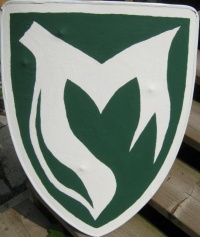Heater shield: Difference between revisions
No edit summary |
No edit summary |
||
| (4 intermediate revisions by one other user not shown) | |||
| Line 1: | Line 1: | ||
[[Image:Fulk shield done.jpg|right|200px|thumb|''A heater shield. Close examination of the picture reveals the placement of bolts for the grip and strap's diagonal orientation.]] |
|||
| ⚫ | |||
| ⚫ | |||
| ⚫ | The heater was held at a 45 degree angle, strapped to the arm and gripped with the left hand. The upper corners of the shield protected the face and shoulder, and the pointed bottom allowed protection for the hip and upper leg. Unlike the [[centre boss|centre-boss]], the heater is not punched towards blows, but instead "rolled" back and forth using the elbow and shoulder as a pivot-point to block incoming blows. |
||
| ⚫ | The heater was held at a 45 degree angle, strapped to the arm and gripped with the left hand. The upper corners of the shield protected the face and shoulder, and the pointed bottom allowed protection for the hip and upper leg. Unlike the [[centre boss|centre-boss]], the heater is not "punched" towards blows, but instead "rolled" back and forth using the elbow and shoulder as a pivot-point to block incoming blows. |
||
| ⚫ | |||
| ⚫ | |||
[[category:armour]] |
[[category:armour]] |
||
Latest revision as of 15:24, 12 July 2010
A heater shield is the most recognizable shield-shape to the modern eye, with a gently curved (sometimes flat) top and a pointed base. It was not referred to as a "heater" in period, that being a Victorian term for this style of shield, since it reminded them of a flatiron.
The heater was held at a 45 degree angle, strapped to the arm and gripped with the left hand. The upper corners of the shield protected the face and shoulder, and the pointed bottom allowed protection for the hip and upper leg. Unlike the centre-boss, the heater is not "punched" towards blows, but instead "rolled" back and forth using the elbow and shoulder as a pivot-point to block incoming blows.
The heater was particularly used by mounted knights in combat, but was prevalent throughout the mid- and late-medieval period.
